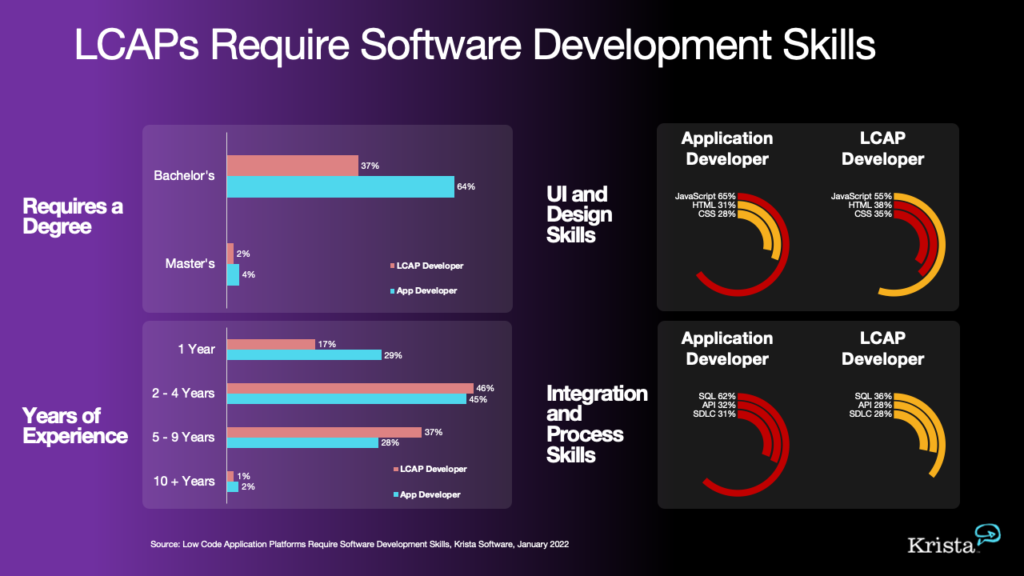Recommended Suggestions For Selecting Low-Code Platform Sites
Wiki Article
Benefits Of Low-Code Application Development In Terms Of Accessibility For Non-Developers
Low-code apps improve accessibility by non-developers (often called "citizen-developers") due to certain key aspects.
Drag-and-Drop Builders: Low-code systems have drag-and-drop interfaces that allow non-developers to create applications visually without writing code. This makes development more accessible to those with no technical background.
WYSIWYG editor: "What you see is the result you will get" editors allow users to create interfaces, workflows and other features in a manner that closely mimics the final outcome. They are easier to comprehend and utilize.
Simplified design of Workflow and Logic
Visual Workflow Modeling: Users may design business processes and application logic using visual flowcharts and models, which are more user-friendly than traditional coding methods.
Pre-built Logic components Low-code platforms have logic components already built (e.g. conditional loops and statements) and can be configured easily, reducing the requirement for complex coding.
Reusable Components and Templates
Template libraries that are pre-built: Numerous low-code platforms have libraries that covers the most popular types of applications, providing those who are not developers a base to build on and later customize.
Reusable Modules and Widgets By using modular and widgets that can be reused, users can simplify the design process, while also reducing the requirements for technical expertise.
Guided Development & Tutorials
Step-byStep Guides: Platforms will frequently provide guided development pathways, online tutorials, or on-screen instructions to assist those who are not developers in developing applications.
Interactive Tutorials Interactive tutorials and hands-on ones allow users to learn through doing. They build confidence using the platform.
Integration with Existing tools
Easy Integration - Low-code platforms can be easily integrated with existing systems and business tools (e.g. ERP, CRM) that give even non-developers the ability to build apps that are compatible within their workflows.
APIs/Connectors: The built-in APIs/connectors make it easy for non-developers connect their apps to external services.
Collaboration Features:
Team Collaboration: Features like real-time collaborative workspaces and shared workspaces allow for non-developers to work effectively with business analysts, developers and other key stakeholders.
Access Control based on Role: Users who are not developers can be assigned specific roles with the appropriate access levels. This allows them to participate in the development process without compromising security or functionality.
Automated Testing, Debugging and Debugging
Low-code platforms are often equipped with testing and debugging software that automates these procedures. This makes it simpler for non-developers to ensure that the functionality of their apps.
Platform detects problems when they happen and suggests solutions. This assists non-developers in solving problems.
The general rule is that low-code development has the ability to open up development to a wider audience. This is a major benefit for developers who are not. Low-code platform platforms empower business users with intuitive, visual and guided tools. They can then actively participate in developing and maintaining the applications. Follow the recommended Low-code Platform for application development for blog tips including software for app development, azure sql server, ms azure sql, develop cross platform mobile app, mobile app development platforms, cross platform mobile development, rad development, build a docker container, cross platform mobile dev, rapid action development and more.

Low-Code Apps Are Affordable.
Low-code development of applications offers a variety of benefits in terms of cost-efficiency which makes it a desirable alternative for companies seeking to optimize their development budgets while still delivering top-quality software. Here are the key benefits: Reduced Development Costs:
Low-Code Platforms: Low-code platforms cut down on the amount of hand-coding required and reduces the time and energy spent by developers in the process of creating applications. This leads to lower costs of labor.
We need fewer resources for developers: Low-code programming is faster and easier, so fewer developers with specialized skills are required. This will drastically lower the cost of hiring and staffing.
Faster Time to Market
Accelerated Development Cycle: Low-code platform visual tools and components allow for rapid development of applications, which allows businesses to launch new products quicker. This could result in faster revenues, as well as improved position in the marketplace.
Rapid Prototyping: Businesses are able to quickly develop and test prototypes, which can cut down the time required during the development process and allows for quicker iterations that are based on feedback from the users.
Lower cost of maintenance:
Simple Maintenance: Applications developed on low-code platforms tend to be simpler to maintain because of their standard components and modular architecture. This will reduce the cost of maintenance and support.
Automated updates: A lot of low-code platforms automate patches and updates, ensuring that the applications are safe and current with no need for a lengthy manual intervention.
Efficient Resource Utilization:
Contributions from Non-Developers Low-code platforms permit people who are not developers to participate in the development process. This allows businesses to leverage the skills of a wider range of employees, reducing dependency on highly-paid developers.
Utilizing IT resources efficiently: IT departments have the chance to concentrate on more strategic projects instead of getting bogged down with simple work tasks for development. Overall productivity and efficiency are improved.
Models of pricing that are scalable:
Subscription pricing: A lot of low-code platform offer different subscription pricing options that increase with use. This allows businesses the ability to adapt their spending according to their growth and needs, without the need for large upfront costs.
Pay-Ass-You Go Options: Some platforms offer pay-as-you-go options that guarantee companies only pay when they utilize resources. This is especially useful for smaller and startup companies with small budgets.
Cost reductions of third-party software:
Low-code platforms come with built-in integrations and functionalities, which can lower the cost of subscriptions to software and licensing.
Pre-Built integrations: These systems and services are integrated with well-known services, reducing the need for custom-developed software, which saves time and cost.
Better ROI
More efficient return on investment (ROI) by combining rapid application development with less expense and a quicker time to market, businesses are able to achieve an increased ROI on their apps.
Increased agility: Businesses are able to respond quickly to changes in the market or in customer demand, which allows businesses to remain relevant and benefit from new opportunities.
Costs of training are lower:
Low-Code Platforms Have User-Friendly Interfaces. The simple and user-friendly interfaces reduce the learning curve of new users. This minimizes the need for intensive training programs.
Accessible Resources: A lot of platforms using low-code provide an extensive range of educational materials, tutorials as well as community support. This eliminates the requirement for formal education as well as the costs associated with it.
Streamlined Collaboration:
Enhanced Collaboration Tools : The collaboration tools integrated into the software facilitate collaboration and communication between the team members. This leads to more efficient project development and lower overhead.
Unified Development Environment. An unified development platform helps reduce costs and streamline workflows through reducing the complexities of managing several tools.
Overall, the cost-effectiveness of low-code application development stems in its ability to lower maintenance and development costs and speed up the time to market, improve resource utilization, and provide flexible pricing models. The combination of these factors can provide firms significant financial benefits and makes low-code an appealing option for businesses looking to increase their development budgets yet still creating robust and adaptable applications. Read the recommended Enterprise application development with Low-code Platform for site advice including app development platform, app dev platform, sso azure, low code platforms, rapid app development, develop cross platform mobile app, rapid app development, develop web application, no code platforms, push alerts and more.

Benefits Of Low-Code App Development In Terms Of Limitations And Customization
Low-code application development offers an integrated approach that offers substantial advantages when it comes to dealing with limitations and permitting modification. These are the key advantages: Resolving limitations
: .
Low-code development platforms are easier to use because they provide pre-built components, templates, and various other tools. They also allow for rapid deployment of even the most complex applications.
Guided Workflows: A lot of platforms have guided workflows as well as wizards to help developers navigate through complicated processes, reducing the risk of mistakes and guaranteeing consistency.
Solutions for scaling:
Scalability integrated into Low-Code platforms: Low-code platforms are often equipped with features that allow for scaling architecture. This lets applications handle greater loads without major redevelopment.
Performance Monitoring: Integrated performance monitoring tools and optimization make sure that the applications run as efficiently as possible, regardless of the size of their application.
Security and Compliance
Low-code platforms have built-in security options, such as security access control that is based on roles encryption, as well as automated checks to ensure security compliance. These security features address commonly-asked security issues.
Platforms are regularly updated with their security and compliance measures to ensure that their applications are secure against threats that change.
Customization capabilities:
Extensibility:
Low-code platforms allow developers to expand functionality beyond what is available by using customized code.
Developers can add extensions or modules to address specific business requirements.
APIs and Integration
API Support. Comprehensive API support allows seamless integration with external systems and services, allowing extensive customisation and connection.
Third-Party Services: Low-code platforms usually offer pre-built connectors for well-known third-party services, which makes it easier to customize and integrate applications.
Flexible UI/UX design:
Customizable User Interfaces: Designers can alter and design user interfaces that meet the requirements for branding and usability, creating a tailored user's experience.
Responsive design: The capability to adapt applications to different screens and devices is included.
Custom Business Logic:
Visual Workflow Builders Visual tools for designing and customizing workflows as well as business logic allow developers to build complex, custom-designed processes with no extensive code.
Conditional Logic & scripting: Platforms can support conditional logic as well as customized scripting to deal with specific business rules.
Data Management
Custom Data Models: Developers have the option to create customized data models for specific applications, tailoring data handling to the specific requirements of business.
Advanced Data Processing: The integration of advanced tools and capabilities for data processing allows for customizing how data is analyzed and used in the application.
The balance between customization and limitations
Frameworks and Standards
Low-code platforms encourage industry best practices and standards: Low code platforms encourage adhering to industry-standard best practices and standards. This allows for the maintenance of high-quality, secure, and scalable applications.
Governance Frameworks Integrated governance frameworks help to ensure that the customizations do not interfere with the integrity, compliance or security of the application.
Iterative Design and Feedback
Rapid prototyping: The capability to quickly prototype and test changes allows developers to refine their applications based on feedback from users improving the app to better meet user needs.
Continuous Improvement: Low-code platforms support continuous improvement, which allows for ongoing customization and enhancement as business requirements evolve.
User Empowerment
Giving Citizen developers the tools they need: The low-code platform's intuitive interfaces let non-developers modify the application. This increases the number of users who are able to improve and customize applications.
Support and Training Resources: Many platforms provide extensive training and support materials to help users customize applications without compromising functionality or stability.
Overall, application development that is low-code gives a strong system for dealing with limitations, and offers a wide range of possibilities to customize. This balance lets businesses create and maintain functional apps designed to meet their requirements while maintaining high standards for quality, security and the ability to scale.
